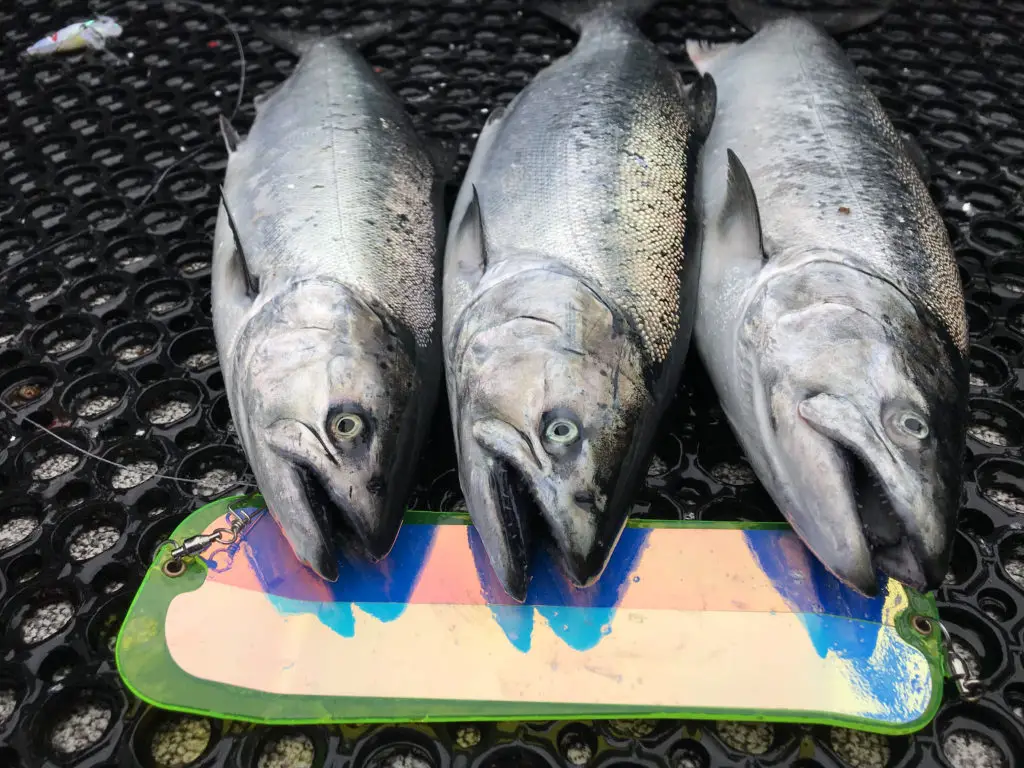Search
Latest Articles
Seattle – Jeff Head Winter Blackmouth
by Andrew Moravec, January 05, 2020
Seattle – Jeff Head Winter Blackmouth
We headed across the Sound at the break of dawn. The morning was calm, and the weather forecast looked good. Winter Blackmouth fishing has been very good. I was pretty excited to get out on Evan’s boat and enjoy a day of fishing.
The tide was going out in the morning. With a five foot exchange, I wondered whether we would see any concentration of bait on the south side of Jeff Head. Usually the bigger the tide the better fishing is. We started at the horseshoe on the south side. Although the bait was scarce, there were ample numbers of Blackmouth.
Ian went right for his old standby, a 4" Tomic Plug. He was far more vigilant about keeping his setup near the bottom, and that extra effort paid off. I don’t think he had his gear in the water more than five minutes before hooking up the first Blackmouth of the day. A beautiful fish that we could take home and enjoy!
Trolling for Blackmouth
The weak tide didn’t allow the bait to develop like it normally does. It did allow us to troll across and even a little into the tide without too much trouble. Evan captained the boat and covered the south and east side of Jeff Head, maintaining a troll path in the 100-140 foot depth range. I followed Ian’s lead and started working the gear as close to the bottom as possible. If I wasn’t dragging the downrigger ball, I was dropping the gear for a bottom check.
Great Day of Winter Salmon Fishing
We ended up catching quite a few fish today. We kept our limit of 3 hatchery fish. We also released two that were too close to the 22? minimum size to be comfortable with, and released several nice wild fish. From what I observed, it seemed like there were quite a few boats that caught their fish today. One of those perfect winter days where the weather cooperated with us and do did the fish!
Andrew Moravec, RipTideFish.com
Click Here for Original Article.
Mike's Take
Our winter blackmouth seasons present a great opportunity to get out on the salt in pursuit of these tasty chinook salmon. Many anglers consider winter blackmouth to be almost as good as springers. They cut either a medium red, or, you’ll also find them a pale pink. Don’t let that color fool you though, these fish are great and catching fresh salmon in the winter is a nice bonus, especially with less and less fishing opportunities for anglers in the Puget Sound area.
The days are shorter in the winter which can be a blessing – no getting up at 4am in order to have gear running at first light. You can have a leisurely breakfast and still be fishing by daylight, generally around 7:30am. Shorter days mean less feeding windows for winter blackmouth, so if the fish are there you can have some pretty fast days. Typically limits are one fish over 22”, but as always be sure to check current fishing regulations. Like their summer cousins, blackmouth can be most active around tide swings. Incoming tides always seem to be a good time to be out there. Because its winter and storms are rolling in on a regular pattern you’ll want to pay close attention to the weather reports. Dressing for the weather means good rain gear, base layers, and if your boat has one a propane heater can keep you out on the water longer and much more comfortable. Keep a close eye on the wind forecasts as well. A nice bonus for winter fishing is you won’t have quite the crowds you would have in the summer.
Trolling for winter blackmouth is very similar to summer fishing – if you’re not making contact and fishing just off the bottom you’re not in the zone. That said, there are always exceptions to the rule and you can definitely find blackmouth suspended. Trolling speeds should be in that 2.5mph range, the downrigger cable should be swept back at a 30-40 degree angle.
Andrew mentioned that they were using Tomic Plugs, but again, much of summer salmon gear can catch these winter fish. Eleven inch flashers in green color patterns with a smaller needle spoon 48” back from the flasher is always a good choice. Experiment with colors and sizes on the spoons and be sure to add some scent.
As to open locations, be sure to keep up to date with the latest WDFW emergency rules section. Often one area will be open and the area next to it will be closed. Know where those boundaries are!
Stay safe and enjoy this winter opportunity as blackmouth season can be very brief!
Mike Carey, Editor




